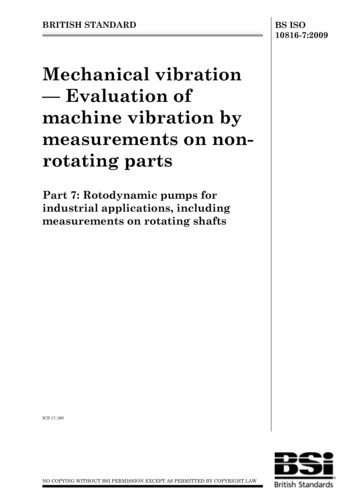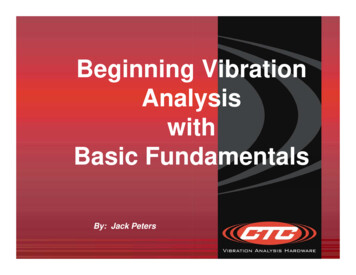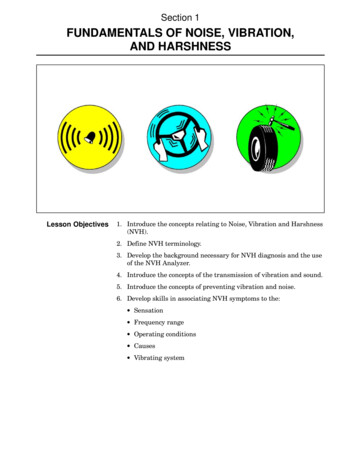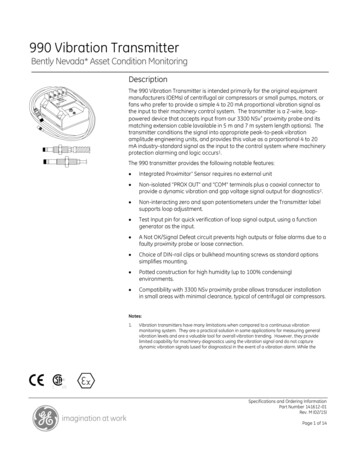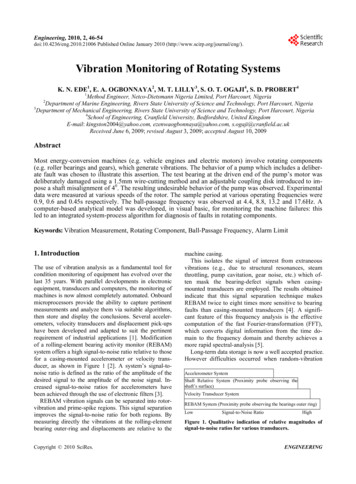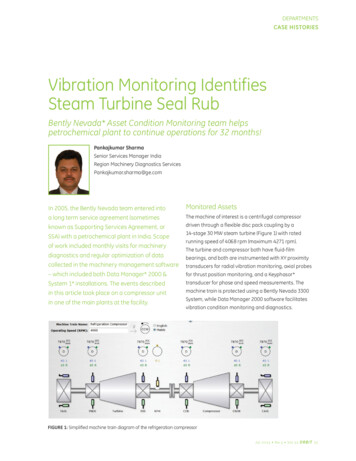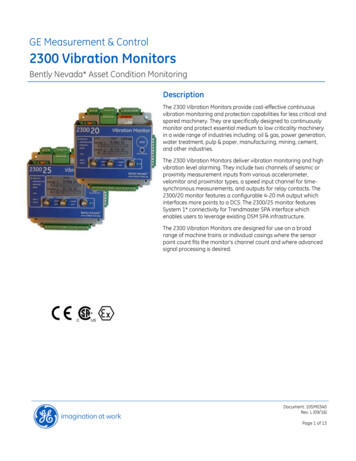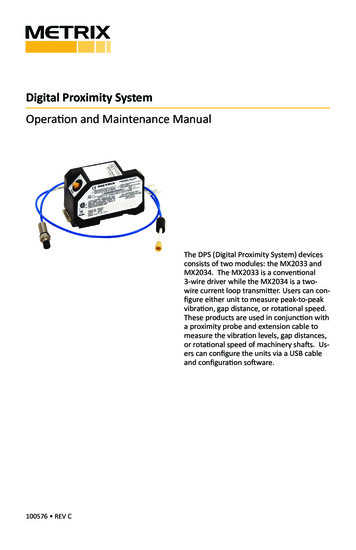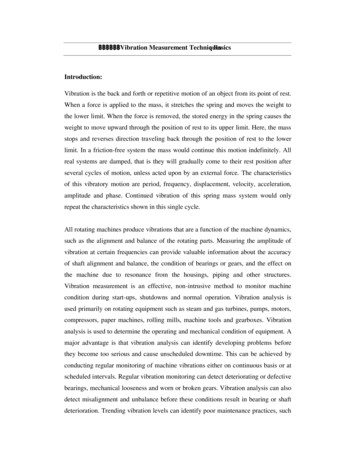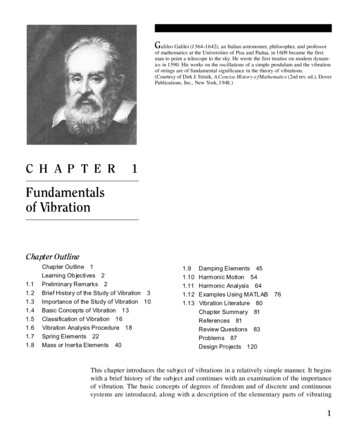
Transcription
Galileo Galilei (1564 1642), an Italian astronomer, philosopher, and professorof mathematics at the Universities of Pisa and Padua, in 1609 became the firstman to point a telescope to the sky. He wrote the first treatise on modern dynamics in 1590. His works on the oscillations of a simple pendulum and the vibrationof strings are of fundamental significance in the theory of vibrations.(Courtesy of Dirk J. Struik, A Concise History of Mathematics (2nd rev. ed.), DoverPublications, Inc., New York, 1948.)C H A P T E R1Fundamentalsof VibrationChapter Outline1.11.21.31.41.51.61.71.8Chapter Outline 1Learning Objectives 2Preliminary Remarks 2Brief History of the Study of Vibration 3Importance of the Study of Vibration 10Basic Concepts of Vibration 13Classification of Vibration 16Vibration Analysis Procedure 18Spring Elements 22Mass or Inertia Elements 401.91.101.111.121.13Damping Elements 45Harmonic Motion 54Harmonic Analysis 64Examples Using MATLABVibration Literature 80Chapter Summary 81References 81Review Questions 83Problems 87Design Projects 12076This chapter introduces the subject of vibrations in a relatively simple manner. It beginswith a brief history of the subject and continues with an examination of the importanceof vibration. The basic concepts of degrees of freedom and of discrete and continuoussystems are introduced, along with a description of the elementary parts of vibrating1
2CHAPTER 1FUNDAMENTALS OF VIBRATIONsystems. The various classifications of vibration namely, free and forced vibration,undamped and damped vibration, linear and nonlinear vibration, and deterministic andrandom vibration are indicated. The various steps involved in vibration analysis of anengineering system are outlined, and essential definitions and concepts of vibration areintroduced.The concept of harmonic motion and its representation using vectors and complexnumbers is described. The basic definitions and terminology related to harmonic motion,such as cycle, amplitude, period, frequency, phase angle, and natural frequency, are given.Finally, the harmonic analysis, dealing with the representation of any periodic function interms of harmonic functions, using Fourier series, is outlined. The concepts of frequencyspectrum, time- and frequency-domain representations of periodic functions, half-rangeexpansions, and numerical computation of Fourier coefficients are discussed in detail.Learning ObjectivesAfter completing this chapter, the reader should be able to do the following:*********1.1Describe briefly the history of vibrationIndicate the importance of study of vibrationGive various classifications of vibrationState the steps involved in vibration analysisCompute the values of spring constants, masses, and damping constantsDefine harmonic motion and different possible representations of harmonic motionAdd and subtract harmonic motionsConduct Fourier series expansion of given periodic functionsDetermine Fourier coefficients numerically using the MATLAB programPreliminary RemarksThe subject of vibration is introduced here in a relatively simple manner. The chapterbegins with a brief history of vibration and continues with an examination of its importance. The various steps involved in vibration analysis of an engineering system are outlined, and essential definitions and concepts of vibration are introduced. We learn here thatall mechanical and structural systems can be modeled as mass-spring-damper systems. Insome systems, such as an automobile, the mass, spring and damper can be identified asseparate components (mass in the form of the body, spring in the form of suspension anddamper in the form of shock absorbers). In some cases, the mass, spring and damper donot appear as separate components; they are inherent and integral to the system. For example, in an airplane wing, the mass of the wing is distributed throughout the wing. Also, dueto its elasticity, the wing undergoes noticeable deformation during flight so that it can bemodeled as a spring. In addition, the deflection of the wing introduces damping due to relative motion between components such as joints, connections and support as well as internal friction due to microstructural defects in the material. The chapter describes the
1.2BRIEF HISTORY OF THE STUDY OF VIBRATION3modeling of spring, mass and damping elements, their characteristics and the combinationof several springs, masses or damping elements appearing in a system. There follows a presentation of the concept of harmonic analysis, which can be used for the analysis of general periodic motions. No attempt at exhaustive treatment of the topics is made in Chapter1; subsequent chapters will develop many of the ideas in more detail.1.2Brief History of the Study of Vibration1.2.1Origins ofthe Study ofVibrationPeople became interested in vibration when they created the first musical instruments, probably whistles or drums. Since then, both musicians and philosophers have sought out the rulesand laws of sound production, used them in improving musical instruments, and passed themon from generation to generation. As long ago as 4000 B.C. [1.1], music had become highlydeveloped and was much appreciated by Chinese, Hindus, Japanese, and, perhaps, theEgyptians. These early peoples observed certain definite rules in connection with the art ofmusic, although their knowledge did not reach the level of a science.Stringed musical instruments probably originated with the hunter s bow, a weaponfavored by the armies of ancient Egypt. One of the most primitive stringed instruments, thenanga, resembled a harp with three or four strings, each yielding only one note. An example dating back to 1500 B.C. can be seen in the British Museum. The Museum also exhibitsan 11-stringed harp with a gold-decorated, bull-headed sounding box, found at Ur in aroyal tomb dating from about 2600 B.C. As early as 3000 B.C., stringed instruments suchas harps were depicted on walls of Egyptian tombs.Our present system of music is based on ancient Greek civilization. The Greek philosopher and mathematician Pythagoras (582 507 B.C.) is considered to be the first person toinvestigate musical sounds on a scientific basis (Fig. 1.1). Among other things, PythagorasFIGURE 1.1 Pythagoras. (Reprintedwith permission from L. E. Navia,Pythagoras: An Annotated Bibliography,Garland Publishing, Inc., New York, 1990).
4CHAPTER 1FUNDAMENTALS OF VIBRATIONString123WeightFIGURE 1.2 Monochord.conducted experiments on a vibrating string by using a simple apparatus called a monochord. In the monochord shown in Fig. 1.2 the wooden bridges labeled 1 and 3 are fixed.Bridge 2 is made movable while the tension in the string is held constant by the hangingweight. Pythagoras observed that if two like strings of different lengths are subject to thesame tension, the shorter one emits a higher note; in addition, if the shorter string is halfthe length of the longer one, the shorter one will emit a note an octave above the other.Pythagoras left no written account of his work (Fig. 1.3), but it has been described by others. Although the concept of pitch was developed by the time of Pythagoras, the relationbetween the pitch and the frequency was not understood until the time of Galileo in thesixteenth century.Around 350 B.C., Aristotle wrote treatises on music and sound, making observationssuch as the voice is sweeter than the sound of instruments, and the sound of the flute issweeter than that of the lyre. In 320 B.C., Aristoxenus, a pupil of Aristotle and a musician,FIGURE 1.3 Pythagoras as a musician. (Reprinted with permission from D. E. Smith, Historyof Mathematics, Vol. I, Dover Publications, Inc., New York, 1958.)
1.2BRIEF HISTORY OF THE STUDY OF VIBRATION5wrote a three-volume work entitled Elements of Harmony. These books are perhaps the oldest ones available on the subject of music written by the investigators themselves. In about300 B.C., in a treatise called Introduction to Harmonics, Euclid, wrote briefly about musicwithout any reference to the physical nature of sound. No further advances in scientificknowledge of sound were made by the Greeks.It appears that the Romans derived their knowledge of music completely from theGreeks, except that Vitruvius, a famous Roman architect, wrote in about 20 B.C. on theacoustic properties of theaters. His treatise, entitled De Architectura Libri Decem, was lostfor many years, to be rediscovered only in the fifteenth century. There appears to have beenno development in the theories of sound and vibration for nearly 16 centuries after thework of Vitruvius.China experienced many earthquakes in ancient times. Zhang Heng, who served as ahistorian and astronomer in the second century, perceived a need to develop an instrumentto measure earthquakes precisely. In A.D. 132 he invented the world s first seismograph [1.3,1.4]. It was made of fine cast bronze, had a diameter of eight chi (a chi is equal to 0.237meter), and was shaped like a wine jar (Fig. 1.4). Inside the jar was a mechanism consisting of pendulums surrounded by a group of eight levers pointing in eight directions. Eightdragon figures, with a bronze ball in the mouth of each, were arranged on the outside of theseismograph. Below each dragon was a toad with mouth open upward. A strong earthquake in any direction would tilt the pendulum in that direction, triggering the lever in thedragon head. This opened the mouth of the dragon, thereby releasing its bronze ball,which fell in the mouth of the toad with a clanging sound. Thus the seismograph enabledthe monitoring personnel to know both the time and direction of occurrence of the earthquake.FIGURE 1.4 The world s first seismograph,invented in China in A.D. 132. (Reprinted withpermission from R. Taton (ed.), History of Science,Basic Books, Inc., New York, 1957.)
6CHAPTER 11.2.2From Galileoto RayleighFUNDAMENTALS OF VIBRATIONGalileo Galilei (1564 1642) is considered to be the founder of modern experimental science. In fact, the seventeenth century is often considered the century of genius since thefoundations of modern philosophy and science were laid during that period. Galileo wasinspired to study the behavior of a simple pendulum by observing the pendulum movements of a lamp in a church in Pisa. One day, while feeling bored during a sermon, Galileowas staring at the ceiling of the church. A swinging lamp caught his attention. He startedmeasuring the period of the pendulum movements of the lamp with his pulse and found tohis amazement that the time period was independent of the amplitude of swings. This ledhim to conduct more experiments on the simple pendulum. In Discourses Concerning TwoNew Sciences, published in 1638, Galileo discussed vibrating bodies. He described thedependence of the frequency of vibration on the length of a simple pendulum, along withthe phenomenon of sympathetic vibrations (resonance). Galileo s writings also indicatethat he had a clear understanding of the relationship between the frequency, length, tension, and density of a vibrating stretched string [1.5]. However, the first correct publishedaccount of the vibration of strings was given by the French mathematician and theologian,Marin Mersenne (1588 1648) in his book Harmonicorum Liber, published in 1636.Mersenne also measured, for the first time, the frequency of vibration of a long string andfrom that predicted the frequency of a shorter string having the same density and tension.Mersenne is considered by many the father of acoustics. He is often credited with the discovery of the laws of vibrating strings because he published the results in 1636, two yearsbefore Galileo. However, the credit belongs to Galileo, since the laws were written manyyears earlier but their publication was prohibited by the orders of the Inquisitor of Romeuntil 1638.Inspired by the work of Galileo, the Academia del Cimento was founded in Florencein 1657; this was followed by the formations of the Royal Society of London in 1662 andthe Paris Academie des Sciences in 1666. Later, Robert Hooke (1635 1703) also conducted experiments to find a relation between the pitch and frequency of vibration of astring. However, it was Joseph Sauveur (1653 1716) who investigated these experimentsthoroughly and coined the word acoustics for the science of sound [1.6]. Sauveur inFrance and John Wallis (1616 1703) in England observed, independently, the phenomenon of mode shapes, and they found that a vibrating stretched string can have no motionat certain points and violent motion at intermediate points. Sauveur called the formerpoints nodes and the latter ones loops. It was found that such vibrations had higher frequencies than that associated with the simple vibration of the string with no nodes. In fact,the higher frequencies were found to be integral multiples of the frequency of simplevibration, and Sauveur called the higher frequencies harmonics and the frequency of simple vibration the fundamental frequency. Sauveur also found that a string can vibrate withseveral of its harmonics present at the same time. In addition, he observed the phenomenon of beats when two organ pipes of slightly different pitches are sounded together. In1700 Sauveur calculated, by a somewhat dubious method, the frequency of a stretchedstring from the measured sag of its middle point.Sir Isaac Newton (1642 1727) published his monumental work, PhilosophiaeNaturalis Principia Mathematica, in 1686, describing the law of universal gravitation aswell as the three laws of motion and other discoveries. Newton s second law of motion isroutinely used in modern books on vibrations to derive the equations of motion of a
1.2BRIEF HISTORY OF THE STUDY OF VIBRATION7vibrating body. The theoretical (dynamical) solution of the problem of the vibrating stringwas found in 1713 by the English mathematician Brook Taylor (1685 1731), who alsopresented the famous Taylor s theorem on infinite series. The natural frequency of vibratio
The subject of vibration is introduced here in a relatively simple manner. The chapter begins with a brief history of vibration and continues with an examination of its impor-tance. The various steps involved in vibration analysis of an engineering system are out-lined, and essential definitions and concepts of vibration are introduced. We learn here that
